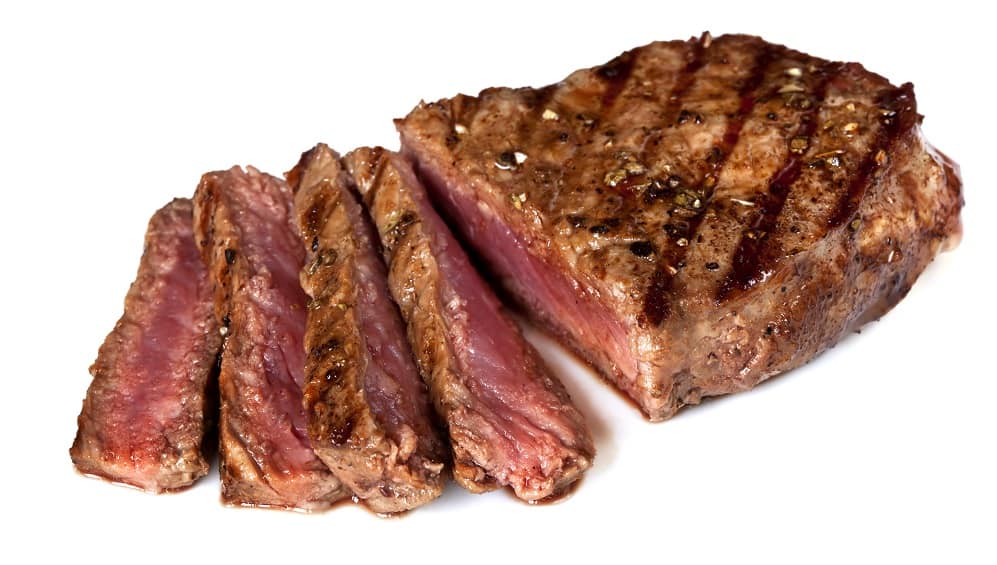Pregnant women should consume their meat only after it has been fully cooked. Proper cooking means achieving the recommended internal temperature that would render the meat safe to eat. For meat steaks, doneness can be judged depending on the heating temperature reached.
All raw and undercooked meat should be avoided during pregnancy, including medium rare steaks. They can be harmful when consumed by pregnant women because of the risk of Toxoplasmosis and other food borne diseases. Fully cooked, well done steaks are a better option and can be safely eaten during pregnancy.
Eating Meat Safely in Pregnancy

There is a growing concern regarding the safety of eating meat products during pregnancy. One reason is that meats are highly vulnerable to microbial contamination because they are a nutrient-dense medium that is ideal for colonization by many pathogens (Kim & Jang, 2018).
Moreover, meats can be contaminated at multiple times during processing, including bleeding, evisceration, skinning and washing. Improper storage and distribution may also result in contamination with food borne microorganisms (Domenech et al., 2015).
According to the NHS, pregnant women can eat meats, including chicken, pork, beef, other poultry, sausages and burgers, as long as they have been well cooked with no trace of pink or blood. On the other hand, cold cured meats, such as salami, pepperoni, chorizo and prosciutto should be consumed with caution unless they were also cooked thoroughly.
However, raw or undercooked meat products should be avoided during pregnancy (Sroka et al., 2019). The NHS further recommends that liver and liver products, all types of pâté (including vegetarian pâté), game meats like goose, partridge or pheasant be likewise avoided throughout pregnancy.
This is because of the risk of getting Toxoplasmosis from raw and undercooked meat, that could be dangerous especially to the developing fetus. In addition, liver has lots of vitamin A, which can also be harmful to an unborn baby. Likewise, game meat may contain lead shot.
In 2019, Jang et al. investigated the microbial content of pork steak based on different levels of doneness. They measured aerobic plate counts and coliform content to measure the presence of microbes in the steak. Results showed that the number of microbes were significantly reduced from medium rare to medium to none detectable in well done steaks.
Food Borne Pathogens in Meat
Toxoplasma Gondii
Toxoplasma gondii is a parasite ranked as one of the most important causes of significant disease burden among the major food borne pathogens. It can be found in raw and undercooked meat, including pork, chicken, venison (Plaza et al., 2020), beef (Belluco et al., 2018), and lamb (Dawson et al., 2020).
It causes the illness called Toxoplasmosis, which can be particularly harmful to an unborn child, as its congenital form can lead to cerebral and ocular damage in the newborn (Sroka et al., 2019). Likewise, latent Toxoplasmosis infections have been linked to the development of behavioral changes and psychiatric disorders in adults (Flegr, 2007).
Toxoplasma gondii can infect humans (Da Silva et al., 2005) through the following means (U.S. FDA, 2018):
- Eating raw or undercooked meat
- Touching hands to the mouth after handling raw meat
- Using contaminated knives, utensils, cutting boards, or other food that came in contact with raw meat
- Drinking contaminated water
- Accidentally ingesting infected cat feces by touching hands to the mouth after gardening or cleaning the cat litter box
- Vertical transmission from mother to baby during an infection in pregnancy (Plaza et al., 2020)
The food borne route of infection with T. gondii is mainly associated with consumption of raw or undercooked meat products (Belluco et al., 2018). In the United States, around half of the cases of Toxoplasmosis infections occur by eating contaminated food. Additionally, about 85 percent of pregnant women are said to be at risk of being infected with this disease (U.S. FDA, 2018).
Pregnant women with Toxoplasmosis typically manifest with swollen lymph nodes, fever, headache, muscle pain or stiff neck, while others may not have any noticeable symptoms (U.S. FDA, 2018). These are usually mild and self-limiting. However, Toxoplasmosis infection can also result in miscarriage, serious congenital defects (Plaza et al., 2020) or stillbirth (Alsammani, 2016).
Women who become infected with T. gondii shortly before conception or during the first trimester of pregnancy pose a lower risk of transmitting the disease to their fetus, but can result in more severe congenital infection. Meanwhile, an infection late in pregnancy is characterized by higher chances of transmission to the fetus but less fetal morbidity (Alsammani, 2016).
In infants, Toxoplasmosis can cause hearing loss, intellectual disability and blindness. Some children can even develop brain or eye problems years after birth (U.S. FDA, 2018). Complications include failure to thrive, hydrocephalus or microcephalus, cerebral calcifications or symptoms of CNS involvement later in life (Alsammani, 2016).
In the United States, an estimated 300 to 4,000 fetuses are infected with Toxoplasmosis each year. Furthermore, up to 80% of children born with Toxoplasmosis develop impairments, ranging from mental retardation to blindness, by age 20 years (U.S. FDA, 2018).
Escherichia Coli
Outbreaks of food borne illnesses caused by Escherichia coli (E. coli) O157:H7 have been attributed to the consumption of undercooked beef (Lien et al., 2020). Other sources implicated are ground beef, hamburger meat and fermented sausages (Jay et al., 2004).
Beef dishes are categorized as to doneness (medium rare, medium, medium well, well done) based on the internal temperature reached after cooking (Chan et al., 2013). According to the findings by Lien et al. (2020), the rate of food borne illnesses from beef contaminated with E. coli decreases from medium rare to medium doneness. Proper cooking of beef reduces this incidence further to almost zero.
How to Cook Steaks Safely
When cooking steaks, a meat thermometer must be used to measure the temperature accurately. According to the U.S. Food and Drug Administration (U.S. FDA, 2020), the following are the recommended safe internal temperatures for cooking different types of meat:
| Category | Food | Temperature (degrees Fahrenheit) | Rest Time |
|---|---|---|---|
| Ground Meat & Meat Mixtures | Beef, pork, veal, lamb | 160 | None |
| Turkey, chicken | 165 | None | |
| Fresh Beef, Veal, Lamb | Steaks, roasts, chops | 145 | 3 minutes |
| Poultry | Chicken & turkey, whole | 165 | None |
| Poultry breasts, roasts | 165 | None | |
| Poultry thighs, legs, wings | 165 | None | |
| Duck & goose | 165 | None | |
| Stuffing (cooked alone or in bird) | 165 | None | |
| Pork and Ham | Fresh pork | 145 | 3 minutes |
| Fresh ham (raw) | 145 | 3 minutes | |
| Precooked ham (to reheat) | 140 | None |
When eating out, pregnant women should order their steak well done. Unfortunately, medium rare and medium steaks should be avoided because these do not reach the minimum safe heating temperatures for cooking.
Pregnant women can also request for the specific temperature they want their steak to be cooked with. After all, it is every pregnant woman’s right to make sure that everything she eats is safe for her and her baby.
Beef Steak
Flat iron, T-bone, sirloin, strip, hangar, flank, minute steak, beef fillet, and all other types of beef steak are safe to eat when cooked to an internal temperature of 145degrees Fahrenheit or 63 degrees Celsius. After removing from the heat, beef must be given at least three minutes to rest. This allows the juices and heat to disperse across the meat. When fully cooked, there should be no red meat or any blood visible, and the steak should feel firm.
Pork, Veal, Lamb, Venison, Game Steaks
The same internal temperature and resting time for cooking beef steaks should be followed in cooking pork, veal, lamb, venison and game steaks.
Chicken, Turkey, Duck, Goose Steaks
Chicken, turkey, duck, goose, and all other poultry steaks are safely cooked once an internal temperature of 165 degrees Fahrenheit or 74 degrees Celsius has been reached. No further rest time has been recommended. Once cooked, there should be no pink color visible, no red or pink juices, and the color should be solid throughout the poultry.
Ground Meat Steaks
Ground beef, pork, veal and lamb steaks are safe when cooked to an internal temperature of 160 degrees Fahrenheit or 71 degrees Celsius. These include burgers, meatballs, sausages, Steak Hache, grills or grill steaks. No further rest time is needed. There must be no pink or red color visible, and the meat should have a solid color throughout.
Meanwhile, ground chicken and turkey steaks should be cooked to the same temperature as in poultry steaks mentioned above.
How to Keep Meat Safe for Consumption During Pregnancy
According to the U.S. FDA (2020), the four basic steps to food safety are the following:
1. Clean
Bacteria can spread not only to your meat, but can also get onto your hands, cutting boards, utensils, and counter tops. Therefore, wash your hands and all surfaces used for preparing meat often.
Other Reminders:
- Wash hands in warm soapy water for at least 20 seconds before and after handling food.
- Wash cutting boards, dishes, utensils, and counter tops with hot soapy water in between preparation of raw meat and poultry.
- Clean the lids on canned goods before opening.
- Use paper towels to clean up kitchen surfaces. If using cloth towels, wash them often in the hot cycle of the washing machine.
2. Separate
Cross contamination happens when pathogens are spread from one food product to another. It is particularly common when handling raw meat. Therefore, keep raw meat and their juices away from vegetables, fruits, or other foods.
Other Reminders:
- Separate raw meat and poultry from other foods in shopping carts, grocery bags, and in the refrigerator.
- Place raw meat and poultry on the lowest shelf in the refrigerator so their juices will not drip on other foods that will not be cooked.
- Never place cooked food on a plate or cutting board that previously held raw meat or poultry.
- Consider using one cutting board only for raw foods and another only for cooked meat.
- Do not reuse marinades used on raw foods.
3. Cook

Meats can be safely cooked when heated to recommended minimum internal temperatures.
Other Reminders:
- Use a food thermometer to measure the internal temperature of cooked foods, and check in several places of the meat.
- The color of meat is not a reliable indicator of doneness.
- Resting cooked meat allows the juices to be reabsorbed throughout the meat.
- Bring sauces, soups, and gravy to a boil when reheating. Heat other leftovers to 165 degrees Fahrenheit.
- When cooking in a microwave oven, cover food, stir, and rotate for even cooking.
4. Chill
Cold temperatures slow the growth of bacteria. Keeping foods in the refrigerator at a constant temperature of 40 degrees Fahrenheit or below is one of the best ways to reduce the risk of food borne illnesses.
Other Reminders:
- Refrigerate or freeze meat or poultry, and other perishables within 2 hours of cooking or purchasing.
- Never thaw food at room temperature, such as on the counter top.
- It is safer to thaw food in the refrigerator, cold water, or microwave.
- Always marinate food in the refrigerator.
Final Thoughts
During pregnancy, it is best not to eat raw or undercooked meat dishes, including medium rare steaks. The risk of acquiring food borne illnesses is high during this time, and can lead to severe consequences to their unborn babies.
Any meat product can be consumed during pregnancy, as long as they have been properly cooked. Ordering for well done steaks is a better option, as well as cooking steaks to achieve the recommended minimum safe internal temperatures.
Pregnant women can consult with their health providers if they have any concerns regarding food consumption.
References
- https://www.nhs.uk/pregnancy/keeping-well/foods-to-avoid/
- Alsammani, M. A. (2016). Sero-epidemiology and risk factors for Toxoplasma gondii among pregnant women in Arab and African countries. Journal of Parasitic Diseases 40(3), 569-579. doi: 10.1007/s12639-014-0558-8
- Belluco, S., Simonato, G., Mancin, M., Pietrobelli, M., & Ricci, A. (2018). Toxoplasma gondii infection and food consumption: A systematic review and meta-analysis of case-controlled studies. Critical Reviews in Food Science and Nutrition 58(18), 3085-3096. doi: 10.1080/10408398.2017.1352563
- Chan, S., Moss, B., Farmer, L., Gordon, A., & Cuskelly, G. (2013). Comparison of consumer perception and acceptability for steaks cooked to different endpoints: Validation of photographic approach. Food Chemistry 136(3-4), 1597-1602. doi: 10.1016/j.foodchem.2012.04.069
- Da Silva, A. V., De Oliveira Mendonca, A., Bergamaschi Pezerico, S., Domingues, P. F., & Langoni, H. (2005). Genotyping of Toxoplasma gondii strains detected in pork sausage. Parasitologia Latinoamericana 60, 65–68. http://dx.doi.org/10.4067/S0717-77122005000100011
- Dawson, A., Ashander, L., Appukuttan, B., Woodman, R., Dubey, J., Whiley, H., & Smith, J. (2020). Lamb as a potential source of Toxoplasma gondii infection for Australians. Australian and New Zealand Journal of Public Health 44(1), 49-52. doi: 10.1111/1753-6405.12955
- Domenech, E., Jimenez-Belenguer, A., Amoros, J. A., Ferrus, M. A., & Escriche, I. (2015). Prevalence and antimicrobial resistance of L. monocytogenes and Salmonella strains isolated in ready-to-eat foods in Eastern Spain. Food Control 47, 120-125. doi:10.1016/j.foodcont.2014.06.043
- Flegr, J. (2007). Effects of toxoplasma on human behavior. Schizophrenia Bulletin 33(3), 757-760. doi: 10.1093/schbul/sbl074
- Jang, A., Kim, H., Kim, D., Kim, J., & Lee, S. (2019). Effects of doneness on the microbial, nutritional, and quality properties of pork steak of different thickness. Food Science of Animal Resources 39(5), 756-767. doi: 10.5851/kosfa.2019.e63
- Jay, M., Garrett, V., Mohle-Boetani, J., Barros, M., Farrar, J., Rios, R., …, & Werner, S. B. (2004). A multistate outbreak of Escherichia coli O157:H7 infection linked to consumption of beef tacos at a fast-food restaurant chain. Clinical Infectious Diseases 39(1), 1-7. doi: 10.1086/421088
- Kim, H., & Jang, A. (2018). Evaluation of the microbiological status of raw pork meat in Korea: Modification of the microbial guideline levels for meat. Food Science and Biotechnology 27(4), 1219-1225. doi: 10.1007/s10068-018-0356-7
- Lien, K., Yang, M., & Ling, M. (2020). Microbial risk assessment of Escherichia coli O157:H7 in beef imported from the United States of America to Taiwan. Microorganisms 8(5), 676. doi: 10.3390/microorganisms8050676
- Plaza, J., Damek, F., Villena, I., Innes, E., Katzer, F., & Hamilton, C. (2020). Detection of Toxoplasma gondii in retail meat samples in Scotland. Food and Waterborne Parasitology 20, e00086. doi: 10.1016/j.fawpar.2020.e00086
- Sroka, J., Bilska-Zajac, E., Wojcik-Fatla, A., Zajac, V., Dutkiewicz, J., Karamon, J., …, & Cencek, T. (2019). Detection and molecular characteristics of Toxoplasma gondii DNA in retail raw meat products in Poland. Foodborne Pathogens and Disease 16(3), 195-204. doi: 10.1089/fpd.2018.2537
- U.S. Food & Drug Administration (2018). Toxoplasma from food safety for moms to be. https://www.fda.gov/food/people-risk-foodborne-illness/toxoplasma-food-safety-moms-be
- U.S. Food & Drug Administration. (2020). Food safety: For pregnant women, their unborn babies, and children under five. https://www.fda.gov/media/83740/download




